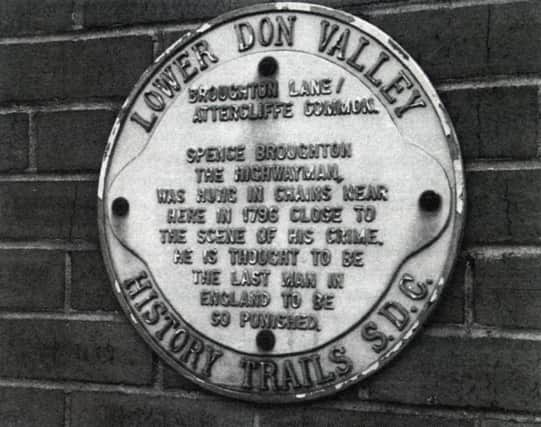The bloody tale of Spence Broughton - hung in a Sheffield street for 36 years


He was sentenced at York Castle and the judge, who wanted to make an example of him, ordered his body to be gibbeted on the site where the robbery took place and so the corpse of Spence Broughton was on show on a raised platform on Attercliffe Common for 36 years before being buried.
Weston Park Museum had the metal shackles and belt thought to be part of Spence Broughton’s gibbet chains on display and a spokesperson for Sheffield Museums said: “ Robbing the mail was a Robbing mail coaches was a serious crime, as the postal service was the main means of communication across the country. As well as letters, the post also delivered money and ‘Bills of Exchange’ which were used to transfer large amounts of money by businesses and individuals.”
Advertisement
Hide AdAdvertisement
Hide AdThe crime took place in early 1971 at Ickles, on the Rotherham edge of Attercliffe Common. Broughton and his accomplice John Oxley stayed in Sheffield the night before the robbery and then walked out of the town on the Rotherham road where they met the mail coming towards Sheffield. However, they intended to rob it on its way back to Rotherham so they lay in wait for it to arrive.
On 4 February 1791, the Sheffield Register reported: “On Saturday night last the post-boy going between this place and Rotherham, was stopped within one mile of the town by a footpad, and robbed of the mail-bag containing the letters for that place and neighbourhood. The villain was dressed in flannel and had a white cap upon his head. He dragged the boy from off his horse, tied his hands and feet, and bound his eyes with a handkerchief.”
Broughton and Oxley escaped towards Mansfield. On their way they went through the contents of the post bag and found that the only item of value was a French bill of exchange worth £123; they disposed of the rest of the contents in a brook and parted, with Oxley proceeding to London to cash the bill.
Clara Morgan, Curator of Social History, for Weston Park’s most macabre exhibit said: “Later that year, a man named John Oxley was caught after robbing the Cambridge mail. He admitted to two more robberies – the Sheffield and Rotherham Mail and the Aylesbury Mail – and implicated Spence Broughton and Thomas Shaw in the crimes. All three were arrested.”
Advertisement
Hide AdAdvertisement
Hide AdIn court in London, Shaw gave evidence against his accomplices and played down his own role in the robberies in order to escape conviction. Oxley also avoided prosecution, escaping from prison before the trial. This left Broughton to stand trial alone, charged with robbery of the Sheffield and Rotherham mail.
The trial took place at York Castle in March 1792, with Thomas Shaw as a witness for the prosecution. Broughton was found guilty of Highway Robbery, sentenced to death, and executed in April of the same year. However, as an example to others, the court also ordered that ‘thereafter the Execution of Spence Broughton, his Body be hung in chains, on a Gibbet to be erected on some conspicuous spot on Attercliffe Common, in the County of York, on the South of the Road leading from Sheffield to Rotherham, not less than Three Hundred Yards from the Road’.
Clara said: “The display of Broughton’s body drew great public interest, with over 40,000 people said to have seen his corpse in the first few days of its arrival at Attercliffe Common. The gibbet was made up of a cage on a high scaffold, with Broughton’s body strapped in and left to decompose. The gibbet was to remain on show for 36 years, becoming a macabre local landmark.
“In 1827 the gibbet was taken down, and Broughton’s remains were buried in a churchyard in Darnall. However, Spence Broughton is still remembered in Sheffield today. The Noose and Gibbet pub on Broughton Lane, Attercliffe takes its name from the events.”